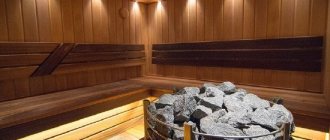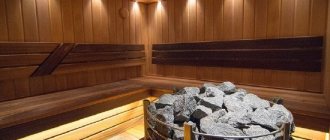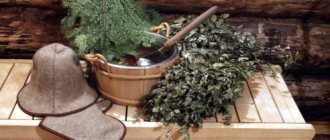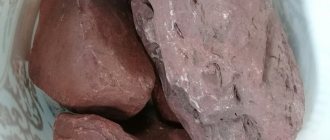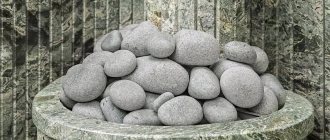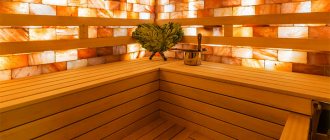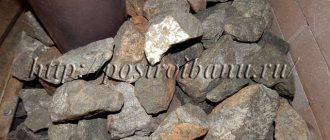If you know which stones are best to choose for a bath , then you can increase the effectiveness of the healing procedure several times, of course, if you give preference to natural materials and take into account their characteristics. Proper use not only allows you to increase the temperature, but also contributes to its better preservation due to the heat capacity of the stones.
By the way, we recommend paying attention to a good assortment of bath stones in the Teplokontakt online store. There is a large selection of various products for baths and saunas, which can be ordered with delivery throughout Russia.
How to choose stones for a bath or sauna?
Choosing stones for a bath is a simple and at the same time complex matter. The following physical parameters of the material should be taken into account:
- density, that is, the greater the weight of the stone, the better;
- heat resistance, the ability of a stone to undergo repeated heating/cooling processes without much loss (at least for quite a long time) of its qualities and properties;
- heat capacity, the property of a stone to accumulate and retain heat, with the purpose of subsequent release into the environment. The higher the heat capacity of the material, the longer it retains the ability to maintain the required temperature after the furnace heating process has stopped.
There is a similar article on this topic - Long-burning wood stoves for the home.
Must be:
- environmentally friendly;
- homogeneous in structure. It is not recommended to use stones for a sauna stove with inclusions: this will cause uneven heating, which will lead to their delamination and destruction;
- without cracks: to check this quality, you should knock the stones against each other or hit them with a hammer. A clear sound will indicate the absence of a defect;
- approximately the same size and shape - this will ensure uniform heating, air and steam circulation. Before you find out which stones are best to use in the steam room based on their structure, preference should be given to specimens with a smooth surface, and based on their shape – oval or round.
Although some believe that chipped stones have a larger area of heat reflection and are more effective. This is true, as is the fact that smooth stones are less susceptible to cracking, which means they will last longer.
In addition, using a hammer you can obtain information about the density of the sample. The following experiment will help you learn about the ability to withstand sudden temperature changes: after heating a stone to the highest possible temperature, it should be sharply lowered into a bucket of cold water. The absence of cracks is a guarantee that a particular specimen will last a long time.
Peridotite
The stone is of igneous origin and comes in a wide range of colors: from light gray to black. It contains no harmful impurities, so the stone is completely safe for people. Peridotite is well suited for a bath, because it has a high heat capacity, can give off heat for a long time and can withstand temperatures up to 1800 degrees. When reacting with carbon dioxide, the stone purifies the environment.
Typically, peridotite is placed at the bottom of the furnace, and covered on top with other stones that have a more pronounced healing effect.
It is quite difficult to say which stones are the best for a bath; each rock has advantages and disadvantages. Many people do the same thing with stones as with bath brooms, that is, they try different options: first one type of stone, then after 3-4 years another. This makes steaming procedures more varied, and also helps everyone choose an option to their liking.
Do you want to steam in a sauna with pleasure and pleasure? Choose the best stones for a bath, approach the issue with all responsibility. Then you are guaranteed good and fragrant steam in the steam room!
How to properly care for stones in a steam room
Even such a durable material as natural stone , especially used in extreme conditions of a bath or sauna, becomes unusable after some time. This explains the reduction in heat output of furnaces by 15-30% per year (depending on the intensity of operation).
It is recommended, on average, once a year (and sometimes more often, if the steam room is used intensively) to conduct a thorough inspection of the stones, after removing them from the oven: identified defects and damage are a reason for replacement.
The rest should be washed under running water and re-laid. The ideal option is to completely replace the stones every 1-2 years, but this is not necessary, especially if the sauna is not used constantly.
When installing a stove, it is important to correctly calculate how many stones are needed for a bath or sauna . It is always difficult for beginners in the bath business, but if you use the rule of 5-6 kg/m2, then you can be sure that the desired effect from their use will be achieved. You can also use another calculation scheme: 1 part of stones per 50 parts of steam room volume.
The type of stove and the shape of the heater must be taken into account: closed or open. In the first case, a higher temperature is provided, so the selected stones must withstand it. In an open heater, the maximum temperatures are much lower, therefore, deciding which stones to choose for a bath will be easier, since it is possible to use less heat-resistant samples.
Mistakes when choosing a stone for a stove, video:
An interesting alternative: cast iron and porcelain
An interesting alternative to natural bath stones are cast iron and porcelain balls (porcelain balls). Of course, such steam does not have any healing effect on the body, but this choice has a number of advantages.
Cast iron cores
Fig 11. Cast iron cores for a bath
Previously, such cores were used in field conditions when it was necessary to obtain excellent steam. It was from those times that the phrase “vigorous steam” appeared.
The heat capacity and thermal conductivity of cast iron is several times higher than that of bath stones. This allows you to warm up the entire heater much faster and, accordingly, evenly warm up the steam room. At the same time, cast iron does not collapse during temperature fluctuations. It quickly gains heat and releases it just as quickly.
Using cast iron cores, the bathhouse attendant can “control” humidity and temperature. Thus, people with pathologies of the heart, blood vessels or respiratory organs will be able to feel comfortable.
We recommend using cast iron cores together with natural bath stones, since otherwise such steam will not have the healing properties and unforgettable aroma for which Russian baths are so famous.
Porcelain balls
Fig 12. Porcelain bath balls
Our parents and their parents may remember when porcelain insulators were placed in the heater. But first they had to be washed, burned, the metal cut and pierced, which can be very dangerous.
But now there are no such difficulties, since you can purchase ceramic balls that are made specifically for heaters from special porcelain.
Such porcelain is characterized by high hardness (of all minerals it is second only to diamond).
The high operating temperature and heat capacity ensure that the balls in the heater do not collapse even under the prolonged influence of constant temperature changes.
We recommend using porcelain balls, like cast iron balls, together with natural stones to ensure the healing properties of steam.
How to properly place stones in a sauna stove?
Choosing the right stones for your bath is only half the battle. It is also necessary to prepare them correctly, and then put them in the heater.
After the stones have undergone a thorough external inspection to look for defects and cracks, it is recommended to pre-treat them in a weak salt solution for 1-2 hours.
Before placing stones in the sauna stove, they need to be washed and dried naturally.
After that:
- large specimens are placed in the lower part of the heater;
- then – average;
- at the top - small, at least 5-6 mm in diameter.
It is also possible to use stones of the same size; in this case, it is preferable that the diameter be in the range from 7-8 to 15 cm.
If the stove is iron and small in size, then you should not use very large samples; it is enough to stay at medium sizes. For electrical products, small stones placed in fairly narrow spaces between the heating elements would be a suitable option.
In some cases, recommendations to use large or medium-sized stones for large wood-burning stoves are rationally justified. In this case, proper heat exchange is ensured. When laying tightly, if small stones are used, this process is somewhat difficult. But not everything is so simple.
In any case, steam and heat will find loopholes to escape, so this point is not so relevant. Especially if you look at the process from the other side. If there are no small stones in the heater, water may get on the metal. In this case, the result is a rather unpleasant, “hard” feeling of steam, sometimes even with a specific metallic taste.
The use of small stones, especially when combined with large specimens, is also supported by an increase in the overall specific heat capacity of the stove. If stones of medium or fine fraction are used, the packing density increases, and this affects the quality of the steam due to the fact that the water rolls down more slowly and reaches the lower, hotter layer, and does not evaporate on the way to it.
The steam is softer and drier. It is based on this principle that one should be guided when the question arises about which sauna stones are better , as well as what size they should be. Even taking into account the fact that steam production is not expected in this case.
It is also important to correctly carry out the hardening procedure for masonry. To do this, you need to gradually heat the stones until they turn red in the lower part, then suddenly pour water on them, cold of course.
After waiting for the stones to cool completely, conduct a visual inspection for the appearance of defects and, above all, cracks; if necessary, reject low-quality specimens and replace them with new ones. In the event that more than 30% of the stones have to be shifted, the hardening procedure should be repeated.
Of course, proper placement of stones in a sauna stove ensures better heat transfer and steam formation, but it is important to monitor the quality and purity of the water used for the stones. There must be a hot and clean liquid, even if special aromatic additives are used. This guarantees not only more steam production, but also preserves the stones.
Laying stones in a sauna stove, video:
Gabbro-diabase
This type of volcanic stone is similar in appearance to dark-colored marble, it is durable and has low water absorption. It is mined in Karelia, where the environmental situation is good. When heated, it expands evenly, takes a long time to heat up, but cools down quickly enough.
Gabrodiabase for baths is one of the most inexpensive types of stones. This is due to several factors:
- It takes a long time to heat up and cools down quickly.
- When overheated, it begins to emit a specific, rather unpleasant odor. As for essential oils, they are not used because carbon deposits immediately appear on the stones.
- Gabbro-diabase must be sorted out frequently and damaged specimens must be removed, which begin to release sand and clog the furnace grates.
The main advantage of gabbro-diabase is its low price. This stone has no decorative or medicinal value.
Collect or buy stones?
get stones for the heater yourself, for example, by collecting them along river banks or on mountain slopes. Samples found near fresh water bodies outperform sea pebbles, a less durable material, although both the former and the latter have undergone centuries of treatment by the sun, wind and water.
The most popular rocks are: jadeite, gabbro-diabase, soapstone and some others, characterized by heat resistance and strength. Less resistant to high temperatures, but having unique and beneficial properties for humans, are basalt, crimson quartzite, and white quartz.
Before determining which stones are best used for a bath , you need to decide where to look for them: buy them in specialized stores or mine them yourself, for example, along the banks of a river.
The first option is preferable and more convenient, but more expensive. The second is free, except for the investment of time and effort, but in the absence of experience and knowledge about stones, it is even unsafe. Especially if there is a temptation to arrange a gathering on a railway embankment.
According to their physical characteristics, these stones may well be suitable for a steam room, but it must be taken into account that they are treated with chemical reagents, which not only emit an unpleasant aroma when exposed to high temperatures, but also produce evaporation that is dangerous to humans. And this is not counting the fact that the mound, in principle, is neither a source nor a supplier of stones for the heater.
An undeniable advantage of buying stones in specialized stores is the opportunity to purchase stones of the desired type, and not just those that can be mined in the natural environment.
Also, in the absence of specific knowledge, you can get the necessary advice from specialists, for example, on how to choose stones for a heater in a bathhouse or how to properly lay them in masonry.
In the store you can purchase a ready-made set of stones, balanced both in composition and size, which have necessarily been treated with special compounds against various microorganisms, including pathogens and aggressive ones towards the human body.
Types of stones for baths, video:
Selecting breeds from an environmental safety point of view
Minerals of uniform color are considered safe for health:
- dunites;
- jadeites;
- peridotites.
Cast iron and ceramics are not dangerous.
You should not use stones containing:
- sulfides;
- creosote;
- inclusions of rich red and yellow shades;
- with a metallic sheen.
You cannot collect granite, crushed stone, or paving stones for a bathhouse near highways or railroad tracks.
It is better to buy stones for backfilling in a store and demand quality certificates from sellers, which will indicate that the product has passed radio control.
An excellent option for finishing the walls of a steam room is salt stones. Beneficial vapors will protect against possible allergens.
Unique properties of jadeite stone
This greenish-colored stone is one of the most durable among those used for heaters; it is classified as a semi-precious rock and, accordingly, its price is one of the highest. Due to the fact that it has:
- beautiful appearance;
- high heat capacity;
- low water absorption;
- unique healing properties,
its use in a heater is completely justified. Moreover, in order to reduce costs, it is possible to purchase not a complete set, but only a few stones and lay them on top of the masonry.
The beneficial effects of jadeite stone, especially in a heated state, on the circulatory, endocrine, genitourinary, nervous and other systems of the body have long been known.
It also has a powerful healing effect for joint pain. Bioenergetics specialists consider it a unique stone for restoring the human energy field.
It is necessary to take into account the fact that the jadeite stone is a source of:
- beneficial infrared radiation;
- air ionization;
- enrichment of water with metasilicic acid.
Its service life is at least 5 years, only after which it gradually begins to lose its effectiveness.
When purchasing jadeite for a steam room, or choosing which stones are better for a heater, you must take into account that for a Russian bath, a split specimen is a suitable option, due to the increased surface area providing a larger amount of steam. Polished stone is more effective in a sauna.
Soapstone: king of saunas
A stone with shades of gray, high strength, the ability to heat up quickly and a large storage capacity. A source of light and pleasant steam. If it is used together with other stones, one should take into account such a feature as dustiness, which can be avoided by thoroughly washing and hardening all samples before placing them in the heater.
The stone is a source of soft “radiant” heat, the radiation wave of which coincides with the length of the thermal wave emanating from the human body.
Its homeland is Finland and Karelia, which explains its popularity in saunas, despite the fact that the cost is quite high.
Raspberry quartzite
When thinking about which stones are best for a sauna stove , you should also pay attention to crimson quartzite, a bright purple-brown color. It is one of the durable rocks that is resistant to cracking - it is not afraid even of cold water, which can be safely poured on the heater. Has increased heat capacity, low water absorption.
How to build a bathhouse from timber with your own hands? - there is more useful information here.
Its medicinal properties are also known:
- has a beneficial effect on the circulatory system, normalizing blood pressure;
- eliminates joint pain;
- helps with migraines, problems associated with changing weather;
- normalizes the functioning of the reproductive system organs.
But, most importantly, porphyry, as crimson quartzite is otherwise called, produces very light steam for a long time even after the stove stops operating. Therefore, in a bathhouse with such a stone you can enjoy the soft, beneficial warmth for a long time.
You will be interested in this article - How to line the inside of a bathhouse with clapboard with your own hands?
Other types of stone in the bathhouse
about what stones can be used for a bath ; there are a lot of rocks. Please pay attention to:
- white quartz is a translucent specimen that looks impressive in the heater, creating a glow, thanks to which it received its second name - “hot ice”. It is better to use in open-type heaters due to low strength and poor resistance to very high temperatures. It is short-lived, despite the fact that it is an expensive material;
- gabbro-diabase, a durable stone with high heat-storing capacity. Many of its characteristics are similar to soapstone, except for one - its price is much lower, which turns it into a real “democrat”, found in many steam rooms;
- basalt is a black stone that lasts as long as possible, almost as long as the steam room will be used. This is facilitated by high density and strength, low water absorption, withstands frequent and sudden temperature changes, and has earned love due to its large heat capacity;
- sea pebbles are the most affordable stone for a steam room. Only samples that have not been exposed to river (sea) water for a long time should be used, in order to avoid an unpleasant odor when heated, and also because “wet” stone is less durable and susceptible to cracking.
Choosing stones for a bath is a difficult but interesting process. Be sure to take into account all the criteria in order for the process of staying in the bathhouse to be as useful and enjoyable as possible.
If you want to diversify your pleasant wellness procedure, you can simply, for example, buy a few jadeite stones, crimson quartzite and decorate your heater with them.
Basalt
The stone is formed from solidified lava of a volcano. It has a dense structure and retains heat perfectly. Basalt is the most durable of all bath stones of volcanic origin; it can withstand strong temperature changes. It heats up quickly, gives off heat for a long time and produces steam well.
Bath basalt has high antibacterial properties, it disinfects the skin, improves the functioning of the respiratory system, helps cure colds and relieves migraines.
Despite its high performance properties, basalt has a fairly low cost.
Raspberry quartzite
This type of stone is rare. It is characterized by high density and minimal moisture absorption, strength, hardness and wear resistance.
Raspberry quartzite is characterized by resistance to cracking, so that even with strong heat, cold water is poured on it. Over time, these stones, even with intensive use, do not change their shape and do not emit harmful substances. But when purchasing, you need to be careful not to come across broken copies.
White quartz
These white stones for a sauna heater are not very suitable. They are environmentally friendly, translucent, and consist only of oxygen and silicon. But quartz is short-lived and can simply burst at high temperatures. Stones must be sorted out frequently and the unusable ones thrown away. On the other hand, white quartz looks good, and plus, when water gets on its hot surface, it releases ozone.
The range of natural materials for steam rooms is very wide. When choosing quartz, jadeite, pebbles, porphyrite for a bath or another type of stone, you need to take into account their characteristics. Even inexpensive items can be durable.
